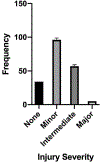Iatrogenic Articular Cartilage Injury in Arthroscopic Hip and Knee Videos and the Potential for Cartilage Cell Death When Simulated in a Bovine Model
- PMID: 32145300
- PMCID: PMC9126109
- DOI: 10.1016/j.arthro.2020.02.017
Iatrogenic Articular Cartilage Injury in Arthroscopic Hip and Knee Videos and the Potential for Cartilage Cell Death When Simulated in a Bovine Model
Abstract
Purpose: To determine the incidence and characterize the severity of iatrogenic cartilage injuries.
Methods: Technique videos of arthroscopic femoral acetabular impingement procedures and meniscus repairs on VuMedi (n = 85) and Arthroscopy Techniques (n = 45) were reviewed and iatrogenic cartilage injuries were identified and graded (minor, intermediate, and major injury) by 2 independent reviewers. To demonstrate that even minor injuries on a cellular scale result in damage, a bovine osteochondral explant was used to create comparable minor iatrogenic injuries at varied forces that do not disrupt the articular surface (1.5 N, 2.5 N, and 9.8 N). Dead chondrocytes at the site of injury were stained with ethidium homodimer-2 and imaged with an Olympus FV1000 confocal microscope. χ2 tests were used for analysis; all results with P < .05 were considered significant.
Results: In total, 130 videos of arthroscopic meniscus and femoral acetabular impingement procedures were analyzed and the incidence of iatrogenic cartilage injury was 73.8%. There were 110 (70.0%) minor, 35 (22.3%) intermediate, and 11 (7.0%) major iatrogenic injuries. All forces tested in the minor injury bovine model resulted in chondrocyte death at the site of contact.
Conclusions: Iatrogenic articular cartilage injuries are common in arthroscopy, occurring in more than 70% of the surgeon-published instructional videos analyzed. At least some chondrocyte death occurs with minor simulated iatrogenic injuries (1.5 N).
Clinical relevance: The high rate of cartilage damage during arthroscopic technique videos likely under-represents the true incidence in clinical practice. Cell death occurs in the bovine minor injury model with minimal contact forces. This suggests iatrogenic cartilage damage during arthroscopy could contribute to clinical outcomes.
Copyright © 2020 Arthroscopy Association of North America. Published by Elsevier Inc. All rights reserved.
Figures




References
-
- Amin AK, Simpson A, Hall AC. Iatrogenic articular cartilage injury: the elephant in the operating theatre: the surgeons’ role in chondroprotection. The bone & joint journal 2017;99-b:1555–6. - PubMed
-
- Chen XZ, Chen Y, Liu CG, Yang H, Xu XD, Lin P. Arthroscopy-Assisted Surgery for Acute Ankle Fractures: A Systematic Review. Arthroscopy : the journal of arthroscopic & related surgery : official publication of the Arthroscopy Association of North America and the International Arthroscopy Association 2015;31:2224–31. 4. - PubMed
-
- Blazquez Martin T, Iglesias Duran E, San Miguel Campos M. Complications after ankle and hindfoot arthroscopy. Revista espanola de cirugia ortopedica y traumatologia 2016;60:387–93. - PubMed
-
- Amin AK, Huntley JS, Bush PG, Simpson AH, Hall AC. Osmolarity influences chondrocyte death in wounded articular cartilage. The Journal of bone and joint surgery American volume 2008;90:1531–42. - PubMed
Publication types
MeSH terms
Grants and funding
LinkOut - more resources
Full Text Sources
Medical

